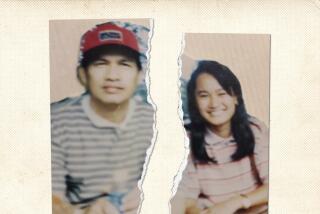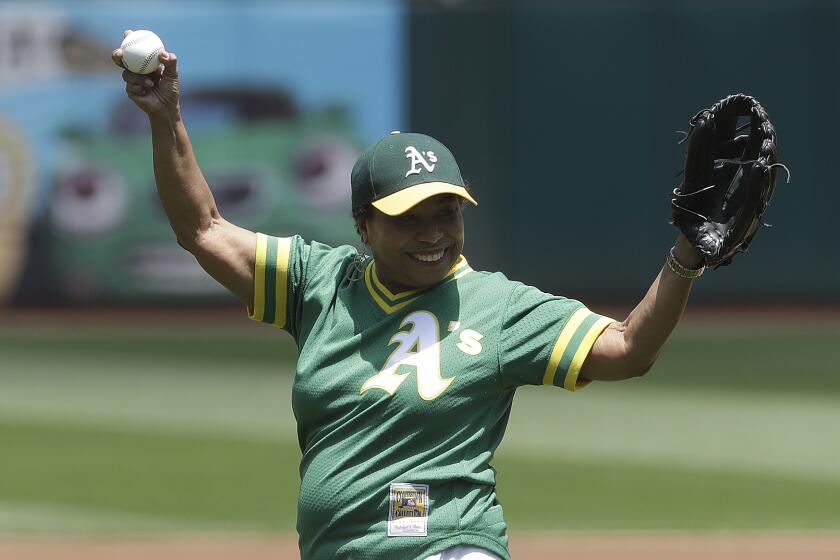Abolish Street Scene, Bradley Recommends : Mayor’s Statement Follows Violent 2-Day Event; One Man Fatally Shot, 40 Injured, 35 Arrested
After a violent weekend at the Los Angeles Street Scene during which one person was fatally shot, at least 40 others injured and 35 more arrested, Mayor Tom Bradley said Monday that the huge festival--begun in 1978 as a tribute to the city’s cultural diversity--should be abolished.
Bradley’s recommendation must be affirmed by the City Council, but it appeared to be the death knell for Street Scene, which attracted about 1 million people to the Civic Center on Saturday and Sunday. For years, the event has drawn festering criticism from the police, who have had to grapple with a small core of rowdy and sometimes drunk rock music fans.
Suggestion From Gates
Minutes before Bradley’s statement was released by a City Hall spokesman, Police Chief Daryl F. Gates called a news conference to recommend that the city-sponsored Street Scene be put out of business unless its organizers are willing to shut down the annual weekend festival before nightfall and stop booking “punk-rock” acts.
Street Scene’s producer, Sylvia Cunliffe, said she was heartbroken by Bradley’s decision.
“I’m disgusted by the behavior of a small segment of the population who I think have destroyed one of the most valuable cultural events in the world,” said Cunliffe, general manager of the city General Services Department.
The worst outbreaks of violence occurred at night. Fighting broke out Saturday when a band spectators had come to see did not perform. On Sunday, a man who was watching a band perform was shot in the back and later died.
Bradley’s recommendation, made from New York, where the mayor was holding a fund-raiser for his gubernatorial campaign, was a surprise.
It was Bradley who ordered Street Scene created after a 1977 discussion with Willie Davis, a former professional football star and owner of a beer distribution business who sold the mayor on the idea of Los Angeles having a festival similar to those held in other cities around the country.
However, crime is a major issue in Bradley’s gubernatorial race against Gov. George Deukmejian. The governor has stressed his own toughness on the subject and repeatedly has accused Bradley of being soft on crime.
Councilman Zev Yaroslavsky, chairman of the council’s Finance and Revenue Committee, said he is not sure whether his colleagues will support Bradley’s proposal and said the city should consider banning the sale of alcohol from its street fairs as an alternative to discontinuing Street Scene.
Street Scene organizers have been reluctant to ban alcohol sales, noting that beer and wine-cooler company sponsorships have been a major source of the $700,000 annual budget.
“The Street Scene has been a double-edged sword,” Yaroslavsky said. “It’s brought great life to the downtown area. On the other hand, it has been a powder keg ready to blow.”
Rise in Attendance
From its first year, Street Scene’s attendance has rapidly swelled. It climbed to the million mark in 1984, when organizers sharply increased the number of youth-oriented rock ‘n’ roll bands offering highly amplified music--often with a particularly aggressive style variously described as “punk” or “heavy metal.”
But as the proportion of teen-age music fans began to vastly surpass the number of families attending Street Scene, a metamorphosis occurred: During daylight hours, the Civic Center was a loud, pleasant, crowded place. At night, its edges became rougher and sporadic clashes between music fans became more frequent, and when police stepped in they were met with flying beer bottles.
It happened enough last year for the captain of the Police Department’s Central Division, which patrols the event, to suggest that Street Scene be scaled down.
Diversity of Acts
In response, Street Scene organizers tried to book a more diverse meld of acts--350 of them on 19 stages. They created a separate stage for classical artists and pledged to worried city officials that they would not schedule punk-rock artists or other bands that attracted unsavory or violence-prone fans.
However, on Saturday night, fans who had come to see the Ramones, a popular veteran rock band, began a series of skirmishes when the band did not show up. Police arrested about 25 people in an altercation. Rocks and bottles were hurled at the 120 helmeted police who tried to disperse the crowd. Fifteen officers and several of the horses they rode into the crowd were injured, police said.
Ironically, officials said Monday, the Ramones had never been booked. Due to a clerical error by Street Scene, the band had been included in the master list of performers that was publicized before the error could be rectified.
“It was purely and simply our fault,” said Milt Petty, who booked bands for Street Scene.
Dispersal Problems
Sunday night, similar confrontations between police and the audience occurred before and as officers dispersed the crowd after the last act of the evening. Some bystanders said street gang members were involved in the disruption, but police said Monday they were not sure.
Concern over the potential for violence at Street Scene began last week when Bradley’s office cut off negotiations between Street Scene organizers and the “rap” group Run-D.M.C., whose last appearance in Long Beach had been marked by street gang violence in which 40 people were injured.
Monday, Deputy Mayor Tom Houston--the same man who had angrily criticized the possibility of Run-D.M.C.’s appearance--said Bradley believes Street Scene “has gotten too big and unwieldy and becoming too much of a draw for the undesirable groups that want to come here and make trouble.
“Maybe in a few years” the Street Scene can be tried again, Houston speculated. “It started as a family, multi-ethnic event and if it ever came back, we’d have to do it as that.”
Weapons Charges
At his news conference, Gates said his officers had made a total of 35 arrests during Street Scene, most of them on suspicion of such felonies as assault with a deadly weapon.
Police said a total of 18 officers were injured, including one whose finger was broken. They said 15 horses were also injured.
Both evenings, police said, they were forced to implement “tactical alerts,” calling in 60 to 70 extra officers to assist the standard Street Scene force of 165 officers.
The Sunday shooting victim, Gilbert Coll, 25, of Maywood, was apparently shot in the back as he stood in front of the International Stage near the Federal Building, He died at County-USC Medical Center, police said. The cause of death was initially reported as drug-related, police said. No suspects have been arrested.
About 35 other Street Scene victims were treated at the medical center for injuries ranging from stab wounds to minor cuts and bruises. Two people were treated for stab wounds. Manuel Mercado, age and address unknown, was listed in critical condition with stab wounds to the abdomen, chest and lower back, and Jaime Romo, 19, of Los Angeles, was in fair condition with a back wound, a hospital spokeswoman said.
Helped by Red Cross
Gary Berger, volunteer chairman for the Los Angeles chapter of the American Red Cross, estimated that between 15 and 25 people had been treated by the Red Cross for injuries related to violence.
Gates and Houston, entering an area of semantics that has plagued rock music since its invention, condemned Street Scene for scheduling punk-rock bands, which Gates said are devoted to violent behavior and attract like-minded fans.
But Cunliffe and Street Scene talent booker Petty said they had in fact taken pains to eliminate such groups and said the critics were confusing mainstream rock acts with the more raucous, hard-line artists.
Herb Melleney, executive vice president of the 200-member International Festivals Assn., said mass downtown festivals are inherently risky.
Other Cities Do It
“Los Angeles does what all the cities do, you bill it as family entertainment, have appropriate security and hope for the best. But there’s no way you can prepare for a sneak attack,” he said. “Unfortunately, it’s like driving along safely and having someone smash into the side of your car--there’s no way to avoid it.”
Having such events at night, “no matter the type, are unfortunately made for disturbances. People will do things that they won’t do in daylight,” Melleney said.
“It ‘s a very difficult type of thing to organize,” said Ron Kirkpatrick, spokesman for Adolph Coors Co., one of the major sponsors of Street Scene for the last two years.
“I know they made a lot of adjustments to create a more controlled situation this year and to make it more family-oriented. And there was more security, such as stronger control over dispensing of beer.
“We had single file rows at the refreshment stands and security people checking identification. We used plastic cups. And the police were checking to see that people didn’t bring bottles and cans into the area. But I was there and I saw a lot of people with coolers.”
Times staff writers Carol McGraw and Victor Merina contributed to this story.
More to Read
Sign up for Essential California
The most important California stories and recommendations in your inbox every morning.
You may occasionally receive promotional content from the Los Angeles Times.










